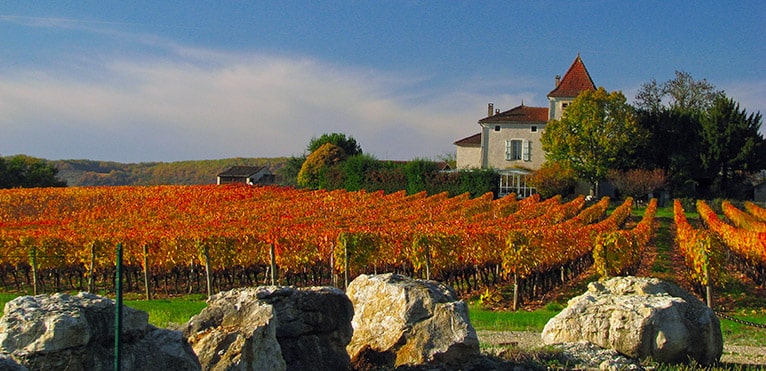
Contents
Cahors is a world-renowned appellation in southwestern France. Wine production is located along the meandering Lot river in the foothills of the Massif Central. It stretches from east to west over 60 kilometers from Cahors to Soturac. The appellation produces only red wines. With a color that ranges from purplish-black to crimson, Cahors has earned the nickname “Black Wine”.
Cahors vineyards stand the test of time
The planting of Cahors vines is directly linked to Roman settlement in the region in the 1st century, making it one of France’s oldest vineyards. But it wasn’t until the 12th century that it began to be appreciated in Europe. It is then exported throughout France and to neighboring countries. In the following centuries, it earned its letters of nobility in Holland, Germany and Russia, where the Tsars made it a ceremonial wine and the Orthodox Church a liturgical wine.
In the 19th century, almost the entire vineyard was devastated by a pest. But the wine survived thanks to the Union des Vignerons Cadurciens, and was finally awarded the Appellation d’Origine Contrôlée in 1971. Since then, growers in the region’s 45 communes have had to comply with a precise charter (minimum planting density of 4,000 vines per hectare, alcohol content between 10.5° and 13° and yield limited to 50 hectolitres/hectare).
The Cahors vineyards benefit from a diversity of soils, terraces and climates.
Cahors is produced on a surface area of 4200 hectares, spread over two distinct terroirs: the slopes of the Lot valley and the Causses.
The soils of the Causses are highly diverse, with limestone, marl and red pebbles at altitudes ranging from 250 to 350 meters. We also find soils rich in yellow and red clay, which help retain water and nutrients. This ensures a constant supply of water and minerals to the vines. As a result, these vines produce late-ripening grapes that are not very fleshy but have remarkable finesse.
In the Lot valley, this terroir is divided into three terraces created by the river Lot. The first terrace is composed of fertile alluvium directly from the Massif Central. The loamy character allows the development of airy, fruity wines. The second terrace is rich in limestone and clay, providing stable hydration for the vines and structure and depth to the wine. The third terrace is made up of sandstone, which adds finesse to the wine, and clay and silica, which give power to fruity wines.
The region benefits from 3 distinct climates. An oceanic climate offering well-distributed rainfall, mild temperatures and the sunshine needed for good grape ripening, with a drier late season favoring good ripening. The proximity of the Massif Central provides a mountain climate, with moderate temperatures that help preserve the vines. Finally, the local climate, due to the sinuosity of the region, influences wind strength, which in turn affects the frequency of rainfall.
Cahors is a powerful wine
The Cahors wine region produces exclusively red wines. The majority of Cahors wines are blends, but there are also single-varietal wines.. A minimum of 70% Malbec is generally used, along with a blend of 30% Tannat and Merlot Noir.
Cahors wines range in color from ruby to purple and garnet, often with purplish hues when young. The nose offers notes of wild berries, spices and cocoa. This broad bouquet sometimes ends with a hint of truffle.
On the palate, the first impression of this wine is memorable thanks to its power coupled with very present tannins. When the wine opens, it’s well-balanced, often with a hint of licorice, violets and coffee. The full-bodied aspect of Cahors requires 2 to 3 years’ cellaring to allow its youthful power to give way to a harmonious whole. Cahors is a wine for laying down, and its ageing potential ranges from 4 to 8 years or more, depending on the vintage.
Accompanying ideas with a Cahors
Cahors can accompany a starter based on wild boar (or venison) terrines just as well as a meal featuring game, or beef with Perigueux sauce. An old Cahors will also go perfectly with red meats, game and cep dishes as they are known to be prepared in the region from which it comes. A younger Cahors is perfect with goose gizzards confit in a salad, or a cheese like Cabécou de Rocamadour.
Many great vintages in Cahors
Annual climatic conditions define the exceptionality or otherwise of vintages produced within a geographical area. For the Cahors appellation, the millennium vintage dates back to 2005, while 2000 marks the last exceptional vintage. The great vintages of the 20th century are 1949, 1978, 1982, 1989, 1990, 1995 and 1998. The quality of the 2009 and 2011 vintages also stands out.
The 2 star estates of Cahors?
The Roques de Cana
Located as close as possible to the village of Roques, the motto of the Roques de Cana winery is “finesse, freshness and elegance”. Deeply attached to the region’s history, Cahors winemakers showcase the Malbec grape variety in their cuvées. Aided by an extremely rich terroir, the estate succeeds in sublimating the region’s historical heritage. That’s why the estate’s wines are mentioned every year in the wine press, and also win awards, such as two gold medals at the 2008 Concours Générale Agricole de Paris for its “Vin des Noces” and “Graal Sanctus” creations.
Clos Triguedina
Established since 1830 in the southwest of the Cahors region, the Baldès family has been producing the famous “black wine” on some 60 hectares for 7 generations. The estate’s many AOC Cahors creations sublimate the legendary Malbec grape variety. Regularly mentioned in specialist reviews, Clos Triguedina’s wines won a silver medal at the 2019 Concours Générale Agricole de Paris for the 2015 vintage of Cuvée des Baldès.